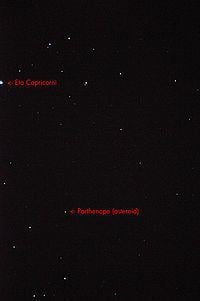Alternative names none Orbital period 1,403 days Orbits Sun | Discovery date 11 May 1850 Minor planet category Main belt Discovered 11 May 1850 | |
 | ||
Pronunciation /pɑːrˈθɛnəpiː/ par-THEN-ə-pee Adjectives Parthenopean /ˌpɑːrθᵻnəˈpiːən/,Parthenopian /pɑːrθᵻˈnoʊpiən/ Discovery site Astronomical Observatory of Capodimonte Similar Annibale de Gasparis discoveries, Other celestial objects | ||
11 Parthenope is a large, bright main-belt asteroid.
Parthenope was discovered by Annibale de Gasparis on 11 May 1850, the second of his nine asteroid discoveries. It was named after Parthenopē, one of the Sirens in Greek mythology, said to have founded the city of Naples. De Gasparis "used his utmost endeavours to realise a 'Parthenope' in the heavens, such being the name suggested by Sir John Herschel on the occasion of the discovery of Hygiea in 1849".
There have been two observed Parthenopian occultations, on 13 February 1987, and 28 April 2006.
On August 6, 2008, during a perihelic opposition, Parthenope had an apparent magnitude of 8.8.
In 1988 a search for satellites or dust orbiting this asteroid was performed using the UH88 telescope at the Mauna Kea Observatories, but the effort came up empty.
Based upon a light curve that was generated from photometric observations of this asteroid at Pulkovo Observatory, it has a rotation period of 13.722 ± 0.001 hours and varies in brightness by 0.10 ± 0.0s in magnitude. The light curve displays three maxima and minima per cycle. The JPL Small-Body Database lists a rotation period of 13.7204 hours.
Mass
In 2007, Baer and Chesley calculated a higher mass and density for Parthenope based on perturbations by the 90 km asteroid 17 Thetis. Baer and Chesley calculated a mass of 6.3×1018 kg with a density of 3.3 g/cm³. 2008 estimates by Baer suggest a mass of 6.15×1018. The 1997 and 2001 estimates by Viateau and Rapaport were closer to 5×1018 kg with a density of 2.7 g/cm³.
